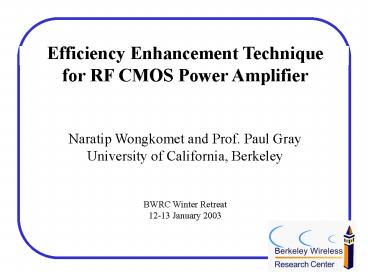A BackEnd Design Flow for Single Chip Radios - PowerPoint PPT Presentation
1 / 17
Title:
A BackEnd Design Flow for Single Chip Radios
Description:
The maximum efficiency while still meeting the linearity requirements. is 32 percent ... Expected Research Contributions. Demonstrate a highly integrated CMOS ... – PowerPoint PPT presentation
Number of Views:33
Avg rating:3.0/5.0
Title: A BackEnd Design Flow for Single Chip Radios
1
Efficiency Enhancement Technique for RF CMOS
Power Amplifier Naratip Wongkomet and Prof.
Paul Gray University of California,
Berkeley BWRC Winter Retreat 12-13 January 2003
2
Existing Implementation
- Power amplifier (PA) is yet to be integrated
with the - rest of the transceiver
3
PA Design Challenges
- Power Amplifier design challenges
- Long talk time High efficiency
- High data rate High linearity
4
Power Amplifier Fundamentals
id
vin
VDD
RLoad
Ct
Lt
VT
vout
time
time
vin
Efficiency
vout
id
VDD
Class A
Class AB, C
Vout
Vout,max
time
- For good linearity, the transistor is biased
such that it is always on. Poor - efficiency. (Class A)
- For good efficiency, the transistor is biased
such that it turns off during - some parts of the cycle. Worse linearity.
(Class AB,C)
5
Typical PA Operating Conditions
time
- PA output power usually is 15-20 dB below its
peak power - If the signal is amplitude modulated, its
average power is lower than - its peak power
6
Doherty Amplifier Concept
- Invented by W.H. Doherty in 1936
- Good power efficiency over a wide range of
- output power
Main Amplifier
Auxiliary Amplifier
Main on Aux. off
Main on Aux. on
Main on Aux. off
Main on Aux. on
?M
?max
?max
?A
Overall efficiency
Efficiency
0
0
Pout,max
Output power
Pout,max
Output power
7
Doherty Amplifier Block Diagram
Pout,max
Paux
Output power
Pmain
Pmain
0
Input power
Pin,max
- Use passive impedance inverter to efficiently
combine the power from - the main and auxiliary amplifiers
8
Doherty Amplifier Operation
I1
Vo
Vm
Zm Zo2/Zmo Zmo RL (1Ia/I1)
Zo 3RL
Im
Ia
RL
Dohertys efficiency
Vmax
?max
Imax
Vm
Ia
Vo
Imax/2
Vmax/3
Typical PAs efficiency
Im
Vin,max
0
Vin,max
0
Vin,max/3
Pout,max
Pout,max/9
0
Vin,max/3
- Auxiliary amplifier actively pulls the load
impedance of the main amplifier
9
Doherty Amplifier Linearity
- Auxiliary amplifier ideally sees zero
impedance - Nonlinearities from the auxiliary amplifier
can be absorbed into the - impedance inverter network
- Auxiliary amplifier can be nonlinear
- Linearity of Main amplifier determines overall
linearity
10
Impedance Inversion Network (1)
- In the original Doherty amplifier, a quarter
wavelength transmission - line is used
- Integrated lumped version is used in this
project
jX
-jX
-jX
ZL
Zin X2/ZL
11
Impedance Inversion Network (2)
jX
RX/Q
-jX
-jX
Main
Aux.
- Low inductor Q causes this
- network to be lossy
Ploss/Pout
Normalized output power
12
Main Amplifier Design
- For good linearity, both transistors should
not go - into triode region.
- To get large output swing, Vdsat of both
transistors - must be small. This implies small
gate-source - voltage swing and large transistors width
13
Interstage Matching
- For good driving efficiency, use L to
- resonate out the input capacitance
- Output stage Cg is 28pF, which would need
- L0.25nH to resonate at 1.9 GHz.
- Use capacitive transformer interstage
- matching to lower the input capacitance
- at the expense of higher voltage swing
vg vin . k/(1k) Cin Cg . k/(1k)
14
Auxiliary Amplifier Design
Input drive (V)
Efficiency ()
VT
VT
Input DC bias voltage (V)
Input DC bias voltage (V)
- CMOS Class C amplifier has poor
linearity-efficiency tradeoff - Bias auxiliary amplifier in shallow class C
- Use the same schematic as the main amplifier
15
Simulation Results
- IS-95 input signal
Efficiency ()
ACPR (dB)
Normalized input
Normalized input
- The signal that is compatible with IS-95
standard is used - The maximum efficiency while still meeting the
linearity requirements - is 32 percent
16
Expected Research Contributions
- Demonstrate a highly integrated CMOS RF Power
Amplifier - with good efficiency and linearity
- Implement design techniques that help break
the - linearity-efficiency tradeoff barrier in the
conventional - PA design
- Develop prototype of CMOS Doherty amplifier
17
Status and Future Works
- Status
- Circuit-level design is completed
- Layout is currently underway
- Future works
- Complete the layout. The expected fabrication
date is in Q1 - of year 2004.































